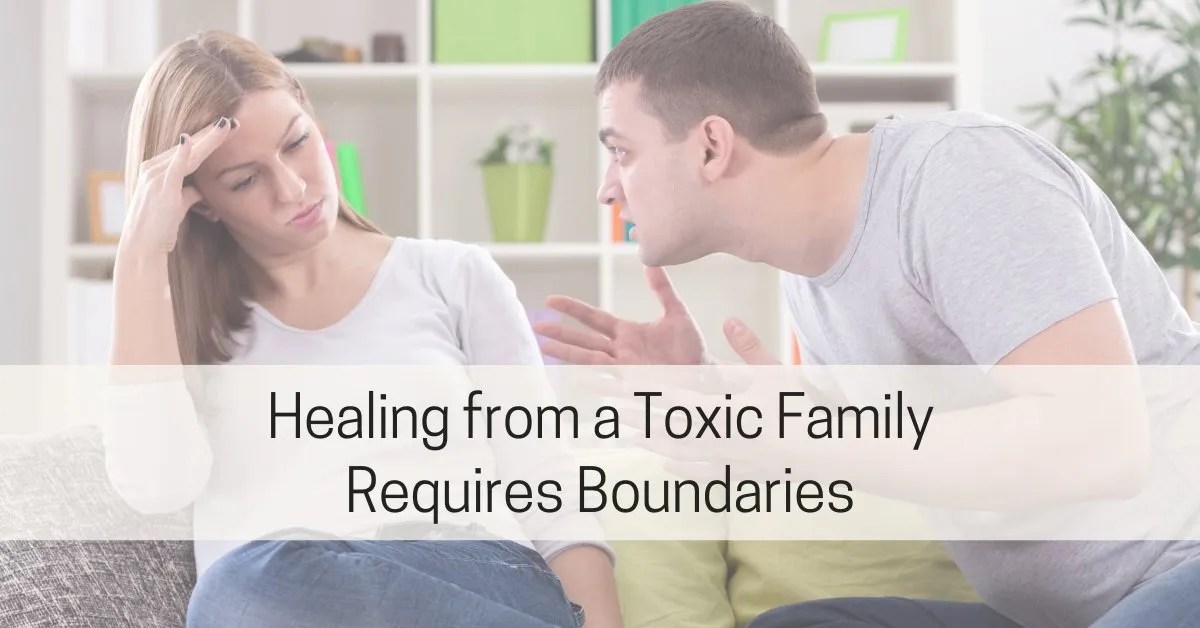Growing up in a dysfunctional family can cause lasting wounds. For adult children who grew up in these environments, healing can be challenging, and navigating relationships with “toxic” family members can be a constant source of pain. A key part of the healing process is setting and sticking to boundaries.
Boundaries are essential for stopping the cycle of ongoing pain, protecting your mental and emotional health, and making space for healing.
Understanding Dysfunctional Family Dynamics
Before delving into the importance of boundaries, I want to briefly describe some of the characteristics of dysfunctional families. Dysfunctional families are marked by instability, lack of communication or ineffective communication, emotional neglect, abuse, addiction, or other harmful behaviors. Boundaries are often blurred or disregarded altogether. Children growing up in dysfunctional families may become enmeshed in toxic patterns, where their needs and identities are secondary to maintaining the family’s dysfunctional dynamics.
For more information on dysfunctional families, read: The Effects of Growing Up in a Dysfunctional Family
The Role of Boundaries in Healing Trauma
Boundaries define what’s acceptable and unacceptable in your relationships. As an adult children of a dysfunctional family, this can mean setting limits on how much time and energy you invest in relationships with family members with toxic behaviors. It may involve asserting your right to personal autonomy and self-care, even if it means creating distance from certain family members.
Setting boundaries with your family doesn’t mean you don’t love them. Setting boundaries is generally an attempt to stay connected and have a functional, mature relationship with someone. However, some people are not capable of having healthy relationships and distancing yourself from them may be necessary.
Boundaries are good for everyone. Parents and adult children both benefit from having their own space, friends, interests, and beliefs. You shouldn’t feel obligated to share everything, and you certainly shouldn’t feel guilty for wanting some privacy and independence.
Boundaries serve as protective shields, guarding against further harm and allowing you to reclaim a sense of agency over your life. Asserting your needs is an important element of breaking free from the patterns of codependency and dysfunction that permeated your upbringing.
Boundaries can aid healing in these specific ways:
- Safety: Boundaries create a safe space for you to heal. By limiting contact with toxic individuals* or setting clear expectations for interactions, you can minimize further emotional harm.
- Self-Esteem: Healthy boundaries communicate your self-worth. They show that you deserve and expect respectful treatment and will not tolerate mistreatment.
- Reduced Triggers: Toxic family members often engage in behaviors that trigger negative emotions or memories. Boundaries help to minimize exposure to these triggers, allowing you to begin processing past trauma in a safe and controlled environment.
- Reduced Stress: Toxic interactions can be incredibly draining. Boundaries help to manage the amount of stress you are exposed to, allowing you to focus on health and healing.
- Self-Care: By prioritizing your well-being through boundaries, you learn to treat yourself with kindness and respect, a crucial step in healing from trauma. Boundaries can also free up the time, money, and energy you need for other healing activities.
- Breaking the Cycle: Dysfunctional family patterns are often passed down through generations. Setting boundaries disrupts these patterns and allows you to build healthier relationships based on mutual respect and genuine connection. When you prioritize your own well-being, you set a powerful example for future generations, demonstrating that it’s possible to overcome dysfunctional family patterns.
What kind of boundaries do you need to set? Read about the 7 types of boundaries everyone needs.
Dealing with Resistance from Your Family of Origin
Setting boundaries in a dysfunctional family is often met with resistance and anger. Family members accustomed to crossing boundaries often react negatively to attempts to enforce limits. They may employ guilt, manipulation, or coercion to maintain the status quo.
Moreover, you may have difficulty asserting your boundaries because you’re grappling with your own feelings of guilt, obligation, or fear of abandonment. You may wrestle with internalized beliefs that prioritize familial harmony over your own well-being, making it challenging to break free from the cycle of dysfunction.
Here are some tips to support you in setting boundaries with your family:
- Start small: Don’t overwhelm yourself. Begin with a small, manageable boundary and gradually build from there.
- Be clear and direct: Communicate your boundaries clearly and directly. Use “I statements” to avoid accusations. For example, “I feel uncomfortable when you talk to me in that tone. Let’s take a break from this conversation.”
- Be prepared for pushback: Expect resistance. Family members may try to guilt or manipulate you into breaking your boundaries. Stay firm, restate your boundaries if appropriate, and take the time and space you need.
- Focus on yourself: Don’t try to control how others react. You can only control your own actions and responses. Focus on ways to meet your own needs rather than trying to get others to change.
- Seek support: Healing from trauma is a big undertaking and you don’t need to do it alone. Seek support from a therapist, support group, and friends who “get it.”
Staying Motivated
You will likely have setbacks and moments of doubt as you set boundaries with your family of origin. It’s important to remember that healing is not linear. Be patient with yourself. Celebrate your successes and learn from setbacks. Remember, with each step you take toward healthier boundaries, you are creating space for self-compassion, growth, and ultimately, healing.
©2024 Dr. Sharon Martin, LCSW. All rights reserved. Photos courtesy of Canva.com.
*The term “toxic people” is used in this article to describe people who consistently exhibit manipulative or harmful behaviors. It is not the ideal term and I’d prefer not to label people at all. However, using this popular term allows people searching on the internet to find pertinent resources, such as this article.
Read More
The No-Nonsense Guide to Setting Boundaries with Toxic People
This 25-page digital guide contains tips and strategies that I’ve honed over 20 years as a psychotherapist. It has an interactive style that asks you to respond to reflective questions to help you apply what you learn.
Publisher: Source link





